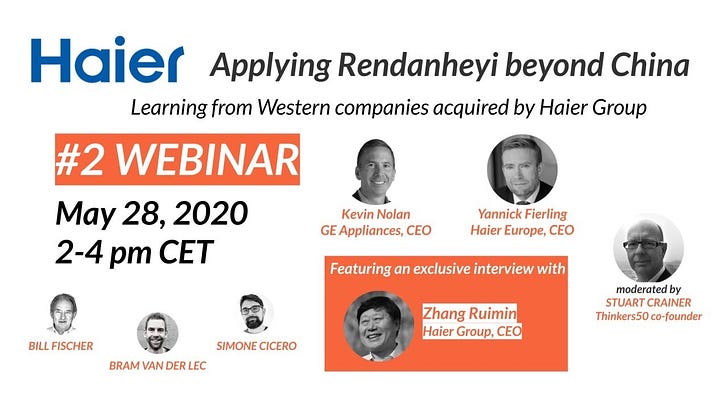Is radical emergent strategy from the edge the future of foresight and strategy?
An examination of strategy in the Haier model
The week before last I participated in three days of training in the Haier organisational model Rendanheyi.
As part of that process I was exposed to the following video:
At 37:24 Kevin Nolan, the CEO of GE Appliances describes the effect of Micro-enterprises (see below for explanation) driving the strategy processes. Products and ways of doing things are emerging from ideas that a top down strategy process would never have supplied.
At 45:31 he answer a question on the strategy function as states that he no longer has a strategy function. What CEO of a US$6 billion company would say that? The reality is that strategy emerges from the parts of the organisation that interact with the customer. Which does not bode well for strategy experts in the future (Kevin Nolan actually says people with MBAs that are strategy experts but have not done much can be very damaging because they don’t know the market).
The overall Haier model is quite complex and dynamic and continually changing and it has taken me a while to understand it. It is also being applied differently in Europe than it is being applied in the USA and it is different again in China A simplified version (that does not give the system full justice) is:
Micro-Enterprises
Haier itself has roughly 80,000 employees, but inside the organisation are 4,000 micro-enterprises that on average consist of 20 people. Those micro-enterprises run their own profit and loss, have the right to make decisions, have the right of hire and fire, and have the right to distribute compensation. They are the core of the model and must serve customers, either internally or externally
Anyone inside (or indeed outside) Haier can propose a micro-enterprise for a business idea to serve customers and apply for funding. They are funded in what looks like a venture capital process, but inside a company ecosystem rather than out in the wild.
Industry Platforms
Industry platforms inside Haier serve three functions:
They fund micro-enterprises (or don’t).
They determine the overall scope and focus of the organisation.
They are responsible for branding.
Shared Services Platforms
Functions like finance/HR/legal/IT have been broken up into Micro-enterprises and placed on platforms. For example HR has been broken up into Micro-enterprises that provide hiring services, and others than provide compensation advice. Interestingly part of the income that these Micro-enterprises make is based on performance. For example in HR in some cases income is determined by the success of the employee in the Micro-enterprise that join, flowing back from bonuses and profits. A distinctly different model from standard recruitment processes. The micro-enterprises on these platforms compete with other internal Micro-enterprises and external services. There is no requirement that Micro-enterprises only use internal services.
Ecosystem Micro-Communities (EMCs)
The ecosystem Micro-Communities are where it all comes together. An individual Micro-enterprise can propose an EMC that serves a customer scenario. They put out requests for the services they need and other Micro-enterprises put in bids to supply those services. This might include manufacturing services, compliance services, IT requirements, marketing, logistics, design ,etc. The relationships between the successful bidders that form an EMC are then governed by smart contracts. Three key points in how these EMCs operate is that:
A Micro-enterprise can be part of several EMCs at any one time.
Customer scenarios that provide ecosystem type revenues rather than just transactional revenues for products or services are prioritised with some ecosystem revenue flowing back to the original Micro-enterprise that created the opportunity.
There is a continual review process between the Micro-enterprises. Negative reviews impact on the ability of those Micro-enterprises to get future opportunities. This make the whole process very competitive in terms of providing customer value.
Conclusion
All of this comes together to create an organisation that is adaptive and resilient in the face of change. It also creates an organisation where strategy emerges from the interactions rather than from some grand plan, or a top down strategy approach. This approach has some fantastic advantages but it also may have some weaknesses. For example where is the overall situational awareness that allows the whole organisation to understand the landscape it is operating in? It is easy to see situations where short term decisions based on customer wants could lead part of the organisation down rabbit holes. In the end I am sure Haier are thinking about these things and also whether the strengths outweigh the weaknesses. Haier has constantly reinvented itself over the last 38 years and I cannot imagine that stopping.
I am working on ways to apply this sort of thinking to the not for profit sector in Australia as well as talking to commercial clients about Haier as part of an overall approach to platform strategies. Contact me if you want to discuss those approaches.



